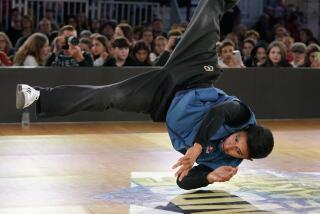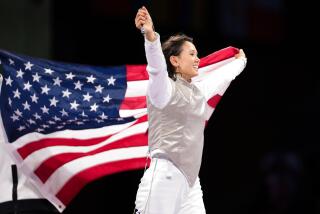En Garde! : Swashbuckling Movies Have Helped Thrust the Dashing and Demanding Sport of Fencing Back Into Public’s Eye
- Share via
If Kevin Costner as Robin Hood can do for fencing what Madonna has done for lingerie, there may not be enough foils to go around.
But fencing aficionados say that their sport was on the upswing even before the trailers for the latest version of the Robin Hood saga hit the screen.
Fencing has become popular as a way to handle stress and tone up the body and mind. Others take up the sport to improve their chances of appearing in Hollywood’s latest swashbuckler movies.
The resurgence of the sport can be seen, among other places, in West Los Angeles, just beyond a makeshift sign reading Rue des vieux Colombiers, where men and women still live by the art of the sword.
Shouting en garde! and working up enough steam for a flying thrust, they attempt to regain chivalry lost in traffic jams, duel for honor over challenged parking spaces, or simply feel the burn while getting a good workout.
“Most people don’t realize the workout you get while fencing,” said Ted Katzoff, 48, founder of the Westside Fencing Center in Culver City. “After 15 minutes, you’re really exhausted.”
The sport has become so popular that the U.S. Fencing Assn., founded in 1891, added three new youth events to its competitions two years ago. And in 1985, Katzoff, along with the Los Angeles-based Amateur Athletic Foundation, helped create a high school fencing program. Eight participating Los Angeles public high schools now hold monthly tournaments.
The renewed interest in aristocratic aerobics, said Katzoff, has boosted attendance at his center from a few dozen weekly lessons offered when the center formed in 1984, to the 200 individual 15-minute weekly lessons taught by 10 coaches today.
Robert Randolph, fencing instructor at Salle Grenadier, which offers weekly lessons in Beverly Hills and Pasadena, said his club has doubled to more than 100 members in the past two years.
“Fencing holds a natural attraction for people,” Randolph said. “It’s a good sport for persons of varying physical and mental aptitudes. I have one fencer who is 6 feet, 3 inches tall and weighs 300 pounds--he’s built like a bear--and there’s also a petite woman who practices with us. People simply adopt different fencing styles that complement their physical size.”
Other area fencing clubs include Salle Couturier, which meets at Lindburg Park in Culver City, and Salle de Y, which meets at the Beverly Hills YMCA. Salle Mori and Salle Gascon both gather at the Westside Fencing Center, located in an old shipping and receiving bay in the old Helms Bakery building. Clubs charge about $30 for a 15- to 20-minute lesson.
Most clubs report an increase in the number of women interested in the sport. At the Westside Fencing Center, women once made up about 20% of fencers. Now the sport is practiced equally by men and women.
Palms resident Jennifer Sakurai was encouraged to take up fencing after a co-worker who fences saw her brandishing a letter opener in an attempt to fend off a pesky mail clerk. “I was immediately hooked on the sport,” said Sakurai, 25, who visits the Westside center three to four times each week. “The movements are quick, yet so precise.”
Sakurai said she concentrates 90% of her fencing efforts on trying to relax. “If you see a sword coming at you, your natural inclination is to tighten up and flail at it,” she said. “But the key is to become calm.”
Katzoff calls it “Zen fencing. Fencing could be called the martial art of the West since it requires a high degree of mental focus,” he said. “It’s largely a game of ideas--impressing my ideas upon the opponent, while hopefully fending off his ideas.”
Much like a Zen archer becomes one with his bow and arrow, trained fencers consider their weapon an extension of their arm, Katzoff said. A state of “physical awareness” is attained wherein movements are executed almost unconsciously.
Fencing champions like Sorin Saitoc, however, think of the sport in more basic terms. “From the start, I was taught to fight and win,” said Saitoc, 28, a 15-time Romanian national champion and two-time world champion finalist who instructs at Katzoff’s center. “You have to, of course, be concerned with the art of fencing, but basically you just have to be good.”
Fencers often “set traps,” said Katzoff, a former UCLA fencing coach, leading their opponents in one direction while launching an opposing tactic.
“You always have to be second-guessing your opponent because they might be faking you out,” Sakurai said. “You have to have plan A, B and C in mind and be ready to use them, all in a matter of seconds.”
On a recent afternoon, Katzoff trained a young boy in one corner of his center’s 6,000-square-foot space. Banners bearing insignias of various fencing clubs hung from the exposed wooden beams of the roof, where large skylights let in square patches of sunlight. A dozen fencers, some fully armored with masks, gloves and jackets, others wearing shorts and T-shirts, parried up and down long strips of colored aluminum laid on the floor. Some made repeated thrusts of their rubber-tipped foils into a padded outline of a heart that hung on a side wall.
“You’re linking the movement of your blade with your foot,” said Katzoff, sliding off his mask as he admonished the boy. “You’re waiting for your foot to move before you move the foil. Your hand has to move faster.” They continued their bout, slicing foils as Katzoff punched relentless dent marks into the boy’s T-shirt. “Don’t tighten up your hand now, keep it loose. Disengage. En garde! “
Fencers play on a “strip,” about 45 feet long and seven feet wide. Each encounter between players is called a “bout.” During a bout, the fencer being attacked defends himself or herself with a “parry” or block, then makes a “riposte” or answering attack.
During competitions, fencers’ vests and weapons are connected by wires to electronic scoring machines, which record on-target stabs. Before electronic scoring was first used in the 1956 Olympic Games, a director (who is still present) and four judges observed bouts, making subjective scoring decisions. Electronic scoring complicated the sport, and today, fencing has a technical manual that weighs 200 pages, one of the largest of any sport.
Beginning fencers, according to coaches interviewed, can expect to pay about $250 for essential equipment, which includes a foil, glove, jacket, pants, underarm protector and a mask. For competition, metallic vests, wires and electric foils are needed, adding $200 to the cost. “Of course, you can also buy a fencing bag to put everything in,” said Katzoff, which adds $30 to the cost.
Fencing competitions may appear tame compared to Hollywood film versions of swordplay that usually incorporate such obstacles as staircases, cliffs and a misplaced foil or two.
The speed of fencing bouts is also increased in films, “because all the moves are choreographed and, hopefully, no one is going to get hurt,” said Dan Speaker, who operates a theatrical combat school at the Westside center.
Katzoff and Speaker, 34, said phones at their center jangle off the hook whenever a swashbuckler film is released. “Everybody wants to be Errol Flynn,” Speaker said. They expect big business from the latest wave of swordplay movies.
Katzoff trained actor Keanu Reeves for his role in the film “Dangerous Liaisons” as well as actors in “The Princess Bride.” F. Murray Abraham and Eric Roberts also trained at the center for their roles in the upcoming film, “By the Sword.” Katzoff, Speaker and instructor Jan Bryant are now training Dustin Hoffman and Robin Williams for their roles in “Hook,” a Steven Spielberg-directed project partly based on Jay M. Barrie’s 1902 children’s story, “Peter Pan.”
Charles Merrill recently sought out Speaker after being hired as an extra for “Hook.” After a few lessons, he decided to take up fencing as a sport because “it keeps my intellect alive,” said Merrill, 57, who lives in West Hollywood.
“No one said I had to learn fencing to be in the movie, but I’ve been taking lessons on my own,” he said. “I was told they would use me in a core group of about 20 pirates on the ship’s deck. I figured I might have to defend myself down there.”


